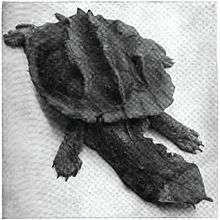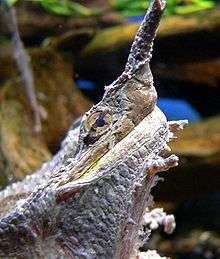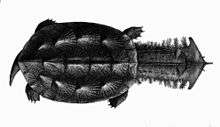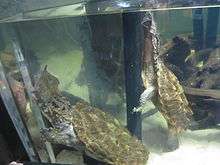Mata mata
| Mata mata Temporal range: Pliocene–Recent | |
|---|---|
| | |
| Shanghai Aquarium | |
| Scientific classification | |
| Kingdom: | Animalia |
| Phylum: | Chordata |
| Class: | Reptilia |
| Order: | Testudines |
| Suborder: | Pleurodira |
| Family: | Chelidae |
| Subfamily: | Chelinae |
| Genus: | Chelus Duméril, 1806[2] |
| Species: | C. fimbriata |
| Binomial name | |
| Chelus fimbriata (Schneider, 1783)[3] | |
| Synonyms[1][4] | |
|
Genus Synonymy Species Synonymy
| |
The mata mata, mata-mata, or matamata (Chelus fimbriata)[1][7] is a freshwater turtle found in South America, primarily in the Amazon and Orinoco basins. It is the only extant species in the genus Chelus.
Taxonomy
The mata mata was described for the first time by French naturalist Pierre Barrère in 1741 as a "large land turtle with spiky and ridged scales" (translation).[8] It was first classified as Testudo fimbriata by German naturalist Johann Gottlob Schneider in 1783. It was renamed 14 different times in two centuries, finally being renamed Chelus fimbriata in 1992.[1][8][9][10]
Anatomy and morphology

The mata mata is a large, sedentary turtle with a large, triangular, flattened head characterized with many tubercles and flaps of skin, and a "horn" on its long and tubular snout.[8] Three barbels occur on the chin and four additional filamentous barbels at the upper jaw, which is neither hooked nor notched.[11]
The mata mata's brown or black, oblong carapace can measure up to 45 cm (18 in) at adult age.[12] The full adult weight is 15 kg (33 lb).[12] The mata mata's plastron is reduced, narrowed, hingeless, shortened towards the front, and deeply notched at the rear with narrow bridges.[11] These may be meant to allow the turtle to resemble a piece of bark, camouflaging it from possible predators.[13] The plastron and bridges are cream to yellow or brown.[11]
The head, neck, tail, and limbs are grayish brown on adults.[11] The neck is longer than the vertebra under its carapace and is fringed with small skin flaps along both sides.[11] Hatchlings show a pink to reddish tinge in the underside edge of their carapaces and plastrons that gradually disappear as they grow.
Each fore foot has five webbed claws. Males have concave plastrons and longer, thicker tails than females.[11]
Habitat
The mata mata inhabits slow moving, blackwater streams, stagnant pools, marshes, and swamps ranging into northern Bolivia, eastern Peru, Ecuador, eastern Colombia, Venezuela, the Guianas, and northern and central Brazil. The mata mata is strictly an aquatic species but it prefers standing in shallow water where its snout can reach the surface to breathe.[14]
Behavior


The appearance of the mata mata's shell resembles a piece of bark, and its head resembles fallen leaves.[15] As it remains motionless in the water, its skin flaps enable it to blend into the surrounding vegetation until a fish comes close.[15] The mata mata thrusts out its head and opens its large mouth as wide as possible, creating a low-pressure vacuum that sucks the prey into its mouth, known as suction feeding.[15] The mata mata snaps its mouth shut, the water is slowly expelled, and the fish is swallowed whole; the mata mata cannot chew due to the way its mouth is constructed.[15]
Reproduction
Males display for females by extending their limbs, lunging their heads toward the females with mouths agape, and moving the lateral flaps on their heads. Nesting occurs from October through December in the Upper Amazon. The 12 to 28 brittle, spherical, 35 mm-diameter eggs are deposited in a clutch.
Diet
The mata mata is carnivorous, feeding exclusively upon aquatic invertebrates and fish.[8][15]
In captivity

Mata mata turtles are readily available in the exotic pet trade and are quite expensive to obtain. Due to their unique appearance, they make interesting display animals. They also grow quite large. However, mata matas are not active hunters, so, like the alligator snapping turtle, they need less space than a large, active species.
As with all aquatic turtles, water quality is one of the keys to keeping this species successfully in captivity. Warm, acidic water is the best type used with a high tannin content that should be maintained all year round. Moderate to heavy filtration is recommended.[16]
References
- 1 2 3 4 Turtle Taxonomy Working Group [van Dijk, P.P., Iverson, J.B., Rhodin, A.G.J., Shaffer, H.B., and Bour, R.]. 2014. Turtles of the world, 7th edition: annotated checklist of taxonomy, synonymy, distribution with maps, and conservation status. In: Rhodin, A.G.J., Pritchard, P.C.H., van Dijk, P.P., Saumure, R.A., Buhlmann, K.A., Iverson, J.B., and Mittermeier, R.A. (Eds.). Conservation Biology of Freshwater Turtles and Tortoises: A Compilation Project of the IUCN/SSC Tortoise and Freshwater Turtle Specialist Group. Chelonian Research Monographs 5(7):000.329–479, doi:10.3854/ crm.5.000.checklist.v7.2014.
- 1 2 3 Duméril, A.M.C. 1806. Zoologie Analytique, ou Méthode Naturelle de Classification des Animaux. Paris: Perronneau, 344 pp.
- 1 2 Schneider, J.G. 1783. Allgemeine Naturgeschichte der Schildkröten, nebst einem Systematischen Verseichnisse der einzelnen Arten. Müller, Leipzig. xlviii + 364 p.
- ↑ Fritz Uwe; Peter Havaš (2007). "Checklist of Chelonians of the World". Vertebrate Zoology. 57 (2): 327. ISSN 1864-5755. Archived from the original (PDF) on 2010-12-17. Retrieved 29 May 2012.
- ↑ Oppel, M. 1811. Die Ordnungen, Familien und Gattungen der Reptilien als Prodrom einer Naturgeschichte derselben. München: J. Lindauer, 86 pp.
- ↑ ICZN. 1963. Opinion 660. Suppression under the plenary powers of seven specific names of turtles (Reptilia: Testudines). Bulletin of Zoological Nomenclature 20:187-190.
- ↑ Giant fossil matamata turtles (matamatas part V), Tetrapod Zoology
- 1 2 3 4 Espenshade III, William H (1990), "Matamata, Chelus fimbriatus", Tortuga Gazette, 26 (5): 3–5
- ↑ Matamata, Chelus fimbriatus, California Turtle & Tortoise Club
- ↑ Chelus fimbriata, The Reptile Database
- 1 2 3 4 5 6 Bartlett, Dick (2007), "The Matamata", Reptiles Magazine, 15 (12): 18–20
- 1 2 (French) Toutes les tortues du monde by Franck Bonin, Bernard Devaux and Alain Dupré, second edition (1998), editions Delachaux and Niestlé/WWF.
- ↑ Encyclopedia of Animals:Mammals,Birds,Reptiles and Amphibians, Harold G. Cogger, Edwin Gould, Joseph Forshaw
- ↑ Rosenfeld, Arthur (1989), Exotic Pets, New York: Simon & Schuster, pp. 153–155, ISBN 0-671-47654-8
- 1 2 3 4 5 Cogger, Harold; Zweifel, Richard (1992), Reptiles & Amphibians, Sydney, Australia: Weldon Owen, p. 112, ISBN 0-8317-2786-1
- ↑ Mata mata Care Sheet
External links
| Wikimedia Commons has media related to Chelus fimbriata. |
| Wikispecies has information related to: Chelus fimbriata |
- Chelus fimbriata, The Reptile Database
